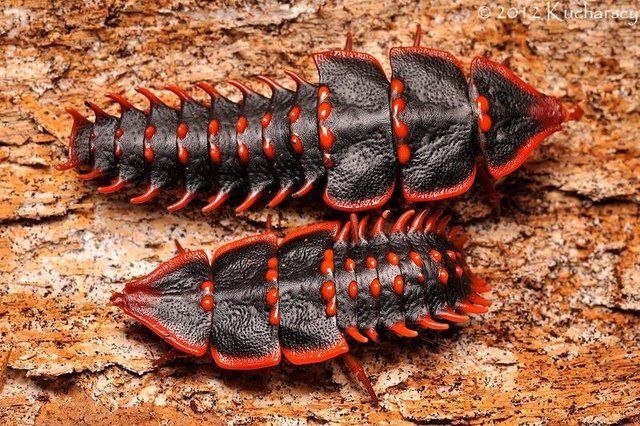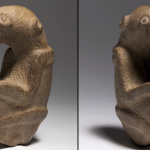Is this insect a fossil or something from another world?

If you’ve ever come across an insect that made you do a double-take, then the Trilobite Beetle might just be the creature you were thinking of. Native to Southeast Asia, this remarkable beetle not only boasts a look that seems straight out of the prehistoric era, but its fascinating biology and behavior make it a true living relic. Despite being one of the strangest-looking insects alive, the Trilobite Beetle is an ancient survivor with some truly unique features that set it apart from all others.
In this article, we’ll delve into the world of the Trilobite Beetle, explore its incredible adaptations, and discover why it has captured the imaginations of those lucky enough to see it. From its striking resemblance to ancient trilobites to its surprising behavior and life cycle, this is one insect you don’t want to miss learning about.
The Mystery of the Trilobite Beetle’s Prehistoric Appearance

At first glance, the Trilobite Beetle might seem like something from a fossil collection, or perhaps even an alien species visiting from another planet. Its armored, heavily ridged body, reminiscent of the long-extinct trilobites, gives it a rugged and ancient look that immediately catches attention. These beetles are native to the rainforests of Southeast Asia, where they thrive in the lush environment.
But what exactly makes this beetle’s appearance so unique, and how does it relate to the prehistoric creatures that roamed the Earth millions of years ago? To understand the significance of its appearance, we first need to take a step back in time.
The Trilobites: The Ancient Relatives
To understand why the Trilobite Beetle has such a distinct look, it’s important to know a bit about its namesake: the trilobite. Trilobites were marine arthropods that lived from the early Cambrian period to the Permian period, nearly 500 million years ago. They were some of the earliest complex life forms on Earth, with hard exoskeletons that offered protection from predators. Trilobites had a segmented body, a hard shell, and various defensive traits that helped them survive in their environments, much like the beetle today.
While trilobites went extinct over 250 million years ago, their legacy lives on in the form of the Trilobite Beetle. The beetle’s appearance is thought to be an evolutionary adaptation, a method of protection that mimics the formidable armor of its ancient relative. It’s as if the Trilobite Beetle is a living fossil, a direct connection to a time long gone.
The Remarkable Armor: A Defense Mechanism
One of the most striking features of the Trilobite Beetle is its armor. The females, in particular, retain this prehistoric appearance throughout their lives. Their shell is dark, hard, and segmented, resembling the outer exoskeleton of the trilobites themselves. This armored appearance acts as an effective defense mechanism against predators.
The armored carapace helps shield the beetle from threats in its environment. Rainforest ecosystems are filled with predators such as birds, frogs, and even other insects. Having a tough outer shell helps the Trilobite Beetle protect itself from being eaten. The thick, rugged armor also serves as camouflage, blending the beetle with the forest floor, making it harder for predators to spot it.
Interestingly, the male Trilobite Beetle looks entirely different. While females maintain their armored, prehistoric appearance, males are much smaller, more delicate, and equipped with wings. This stark contrast between the sexes is a fascinating aspect of the species. The male beetles look almost unrecognizable compared to the females, which leads many to wonder how such a dramatic difference evolved.
The Female Trilobite Beetle: A Living Fossil

Females are the most iconic representatives of the Trilobite Beetle species. Their physical appearance is truly a marvel of nature’s evolutionary design. The armor that covers their bodies consists of tough, ridged segments, which are not only visually impressive but also functional. This armor is made of chitin, the same material that makes up the exoskeletons of many other insects.
As adults, females of the species can grow up to 5 cm in length. Their rigid outer covering helps to protect their vulnerable internal organs and provides a strong defense against predation. However, despite their seemingly indestructible appearance, the females are not invincible. Their armor also limits their mobility, making them slow-moving compared to other beetles. However, they make up for this with their defensive strategies, including hiding in cracks and crevices where predators have a harder time reaching them.
The Male Trilobite Beetle: A Contrast in Appearance
While females maintain their armored appearance throughout life, males of the species are a completely different story. These smaller beetles are not armored at all. Instead, they have delicate, winged bodies that resemble typical beetles in many ways. This dramatic difference in appearance between males and females is known as sexual dimorphism.
The males are often mistaken for an entirely different species due to their small size and winged appearance. This difference in appearance between the sexes has intrigued entomologists and led to speculation about the evolutionary reasons behind such stark sexual dimorphism. Some researchers believe that the males’ wings help them in finding mates or evading predators. The males’ flight capabilities give them the ability to seek out females or escape danger faster than their armored counterparts.
The Life Cycle of the Trilobite Beetle: From Egg to Adult
The Trilobite Beetle’s life cycle is an interesting and complex process that contributes to its unique features. It begins when the female lays her eggs, which are typically found in the moist, sheltered areas of the rainforest floor. Once the eggs hatch, the larvae emerge as small, soft-bodied beetles that bear little resemblance to the adult form.
The larvae go through several developmental stages before transforming into the armored adults we recognize. During these stages, they grow and molt, shedding their exoskeletons to make room for their growing bodies. Over time, they begin to develop the characteristic armor that will protect them through their adult years.
For males, the process of growing wings begins as they mature into their adult form. As adults, males spend much of their time searching for a mate, a task made easier by their ability to fly.
Fun Fact: Are They Fossils or Aliens?

The Trilobite Beetle’s unique appearance has led many to mistake it for something other than an insect. In fact, when people first encounter a Trilobite Beetle, they often think they’ve stumbled upon a fossil or even an alien creature. Its prehistoric look and strange body structure make it one of the most fascinating insects on Earth.
This misidentification is not surprising, given how closely the beetle’s appearance resembles that of ancient trilobites. The beetle’s hard, segmented body and its resemblance to ancient creatures from hundreds of millions of years ago make it an enigma in the insect world.
Some people even go so far as to think that the Trilobite Beetle is a living fossil, a direct link to the past that has managed to survive through the ages. While this is an exciting notion, the truth is that the Trilobite Beetle is a modern-day insect that has evolved in its own unique way to survive in the rainforests of Southeast Asia.
Conservation Status: Protecting the Trilobite Beetle
While the Trilobite Beetle is not currently listed as an endangered species, it is still important to protect its natural habitat. Southeast Asia’s rainforests, where these beetles live, are under constant threat from deforestation, illegal logging, and habitat destruction. The loss of these habitats could jeopardize the future of the Trilobite Beetle and many other unique species that call the rainforest home.
Conservation efforts in Southeast Asia aim to protect these delicate ecosystems and the incredible species that rely on them, including the Trilobite Beetle. By preserving the rainforests, we can ensure that future generations will continue to marvel at the wonder of these prehistoric-looking creatures.














